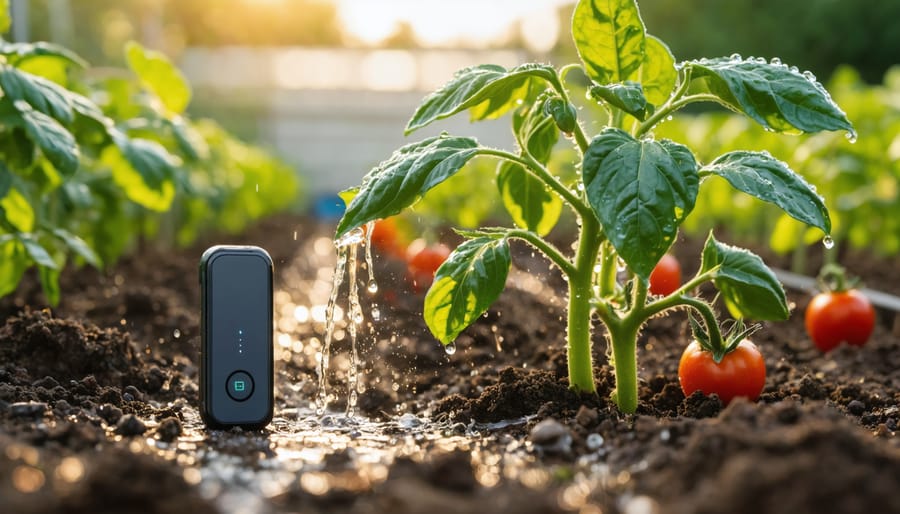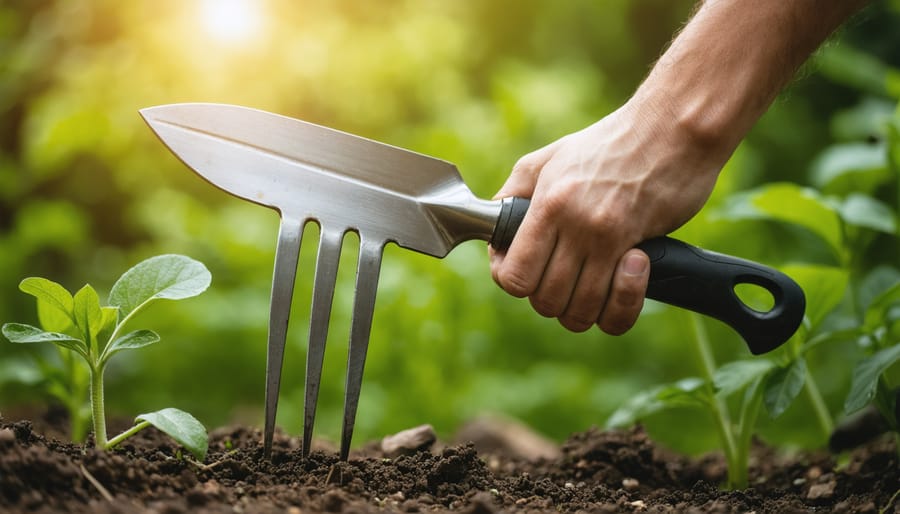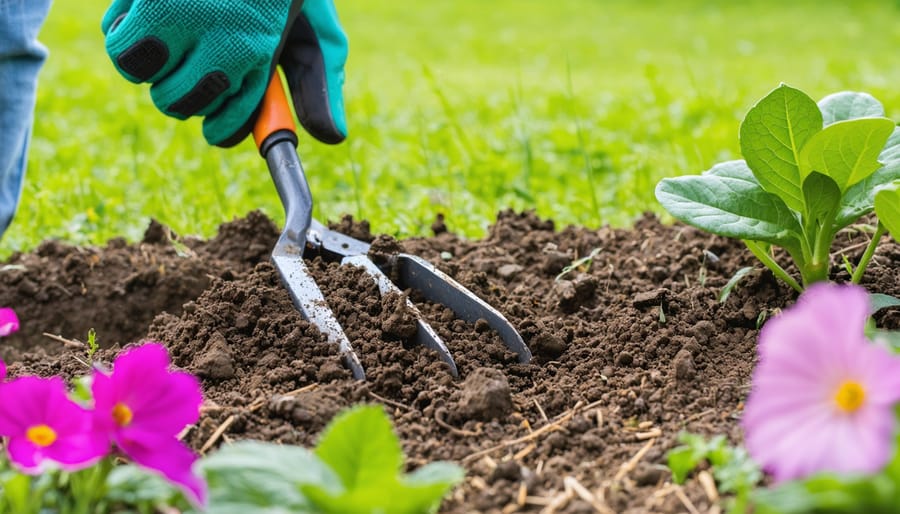**Transform Your Garden with Smart Technology That Actually Works**
Monitor soil moisture levels in real-time using wireless sensors that send alerts directly to your phone, preventing both overwatering and drought stress. Install automated drip irrigation systems with programmable timers to deliver precise water amounts at optimal times, reducing water waste by up to 50% while keeping plants healthier. Track sunlight exposure with digital light meters to identify the perfect spots for sun-loving tomatoes versus shade-preferring hostas, eliminating the guesswork from plant placement.
Gardening electronics have evolved far beyond complicated gadgets gathering dust in your shed. Today’s tools blend seamlessly into your routine, making tasks easier without removing the joy of hands-on growing. Whether you’re nurturing a windowsill herb garden or managing acres of vegetable beds, these innovations work quietly in the background, giving you more time to actually enjoy your garden.
The hesitation is understandable—won’t technology make gardening feel less natural? Actually, the opposite proves true. Electronic tools handle the repetitive monitoring and precision timing, freeing you to focus on the creative, satisfying aspects: planning companion plantings, harvesting ripe produce, and watching butterflies visit your blooms. These devices act as your gardening assistants, not replacements for your green thumb.
From smart sensors to LED grow lights, the electronics market offers solutions for every challenge and budget. The key lies in choosing tools that genuinely address your specific needs rather than chasing every shiny innovation.
Why Electronics Belong in Your Garden (Even If You’re Old-School)
I get it—you’ve been gardening successfully for years with nothing more than a trowel and your intuition. Why complicate things now? Here’s the thing: gardening electronics aren’t about replacing your tried-and-true methods. They’re about giving you more time to enjoy the parts of gardening you actually love.
Take Maria, a seasoned gardener who swore she’d never need “gadgets” in her garden. After installing a simple soil moisture sensor, she discovered she’d been overwatering her tomatoes for three seasons. That one change increased her harvest by 40% and cut her water bill significantly. She still hand-picks every tomato with the same care as always—she just grows better ones now.
The real beauty of gardening electronics lies in their practical advantages. Automated watering systems can save you hours each week, freeing you to focus on pruning, planting, or simply enjoying your morning coffee among the flowers. Water conservation is another major benefit—smart irrigation systems use only what your plants actually need, reducing waste by up to 50%.
For gardeners dealing with mobility challenges or chronic pain, electronics become game-changers. No more dragging heavy hoses or forgetting to water when your back’s acting up. These tools provide accessibility for gardeners who want to maintain their independence in the garden.
Think of electronics as your gardening assistants—they handle the repetitive tasks while you make the creative decisions. You’re still the gardener; you’re just working smarter, not harder. And honestly, isn’t that what good gardening has always been about?

Smart Watering Systems That Actually Work
Soil Moisture Sensors: Your Garden’s Hydration Alert
Soil moisture sensors take the guesswork out of watering—and trust me, that’s a game-changer! These clever devices measure the water content in your soil and alert you when your plants are thirsty or drowning. Most work by measuring electrical resistance between two probes inserted into the soil; dry soil conducts electricity poorly, while moist soil conducts it well.
The benefits? You’ll prevent the two biggest watering mistakes: overwatering (which causes root rot) and underwatering (hello, crispy leaves). I’ve saved countless plants since using mine, especially those finicky ferns that seem to have very particular opinions about moisture levels.
For beginners, I recommend starting with a simple analog probe-style sensor—they’re affordable, need no batteries, and give instant readings. Just stick it in the soil near your plant’s roots and check the meter. Digital versions with Bluetooth connectivity are fantastic if you want smartphone alerts, but the basic models work beautifully for learning your plants’ watering patterns. Place sensors about 2-4 inches deep, away from the stem, for accurate readings.
WiFi-Enabled Irrigation Controllers
Gone are the days of setting a basic timer and hoping for the best! WiFi-enabled irrigation controllers represent one of the most practical advances in smart garden technology, and I’m excited to share why they’ve become absolute game-changers for water conservation.
These clever devices connect to your home WiFi and pull real-time weather data to adjust your watering schedule automatically. If rain is forecasted or already falling, they’ll skip watering—no more overwatering your precious plants or wasting water! Popular models like the Rachio 3 and Orbit B-hyve make installation surprisingly straightforward, even if you’re not particularly tech-savvy.
Most controllers simply replace your existing timer box. You’ll connect the zone wires (they’re color-coded!), mount the unit, and follow the app’s setup wizard. The apps walk you through each step, asking simple questions about your soil type, sun exposure, and plant varieties. From there, they create customized watering schedules that you can adjust with a quick tap on your phone.
I spoke with master gardener Elena Rodriguez, who installed her first smart controller last spring. “I was nervous about the setup, but it took maybe 30 minutes,” she shared. “Now I’m saving about 40% on my water bill, and my garden looks healthier than ever.”
The investment typically ranges from $80 to $250, and many water utilities offer rebates that can offset half the cost.
Growing Lights and Climate Control Electronics
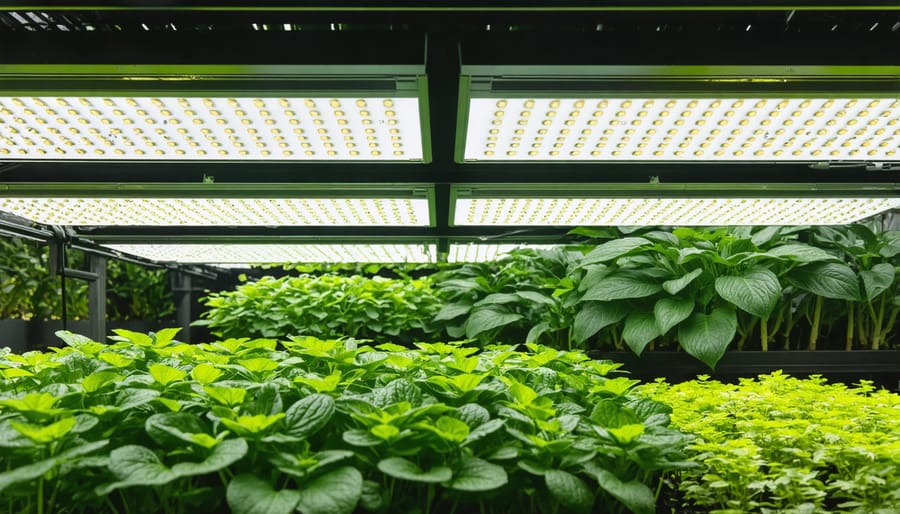
LED Grow Lights for Indoor and Greenhouse Gardening
LED grow lights have revolutionized how we garden indoors, and I’ve seen countless gardeners transform their indoor growing setups with this technology. Unlike traditional bulbs, LEDs let you customize the light spectrum your plants receive—blue light promotes leafy growth, while red encourages flowering and fruiting.
The energy savings are impressive, too. LEDs use about 40-60% less electricity than fluorescent or HID lights and generate minimal heat, reducing your cooling costs. I switched my basement setup last year and noticed the difference in my electricity bill immediately.
Choosing the right light depends on what you’re growing. Leafy greens and herbs thrive under full-spectrum white LEDs, while tomatoes and peppers need lights with enhanced red wavelengths. Look for lights with adjustable spectrum settings if you’re growing various plants—they offer wonderful flexibility.
For beginners, start with wattage recommendations: roughly 30-40 watts per square foot for leafy greens, and 50-80 watts for fruiting plants. Don’t worry about getting everything perfect initially; plants are remarkably forgiving, and you’ll quickly learn what works best in your space.
Temperature and Humidity Monitors
Imagine having a personal assistant who keeps tabs on your garden’s comfort levels 24/7—that’s essentially what temperature and humidity monitors do! These clever devices have become game-changers for gardeners who want to take the guesswork out of environmental conditions.
Modern smart monitors are surprisingly easy to use. Simply place sensors in your greenhouse, raised beds, or near sensitive plants, and they’ll track temperature fluctuations and moisture levels in real-time. The magic happens when they connect to your smartphone, sending instant alerts if conditions drift outside your ideal range. Too cold for your tomatoes at 2 AM? You’ll know immediately and can take action before frost damage occurs.
I spoke with master gardener Elena Rodriguez, who swears by her monitoring system: “Last spring, my humidity alert saved my seedlings from damping off disease. I adjusted ventilation before problems started.”
These devices typically cost between $30-$150, depending on features like multiple sensors, data logging, and integration with other smart home systems. Many models store historical data, helping you identify patterns and make informed decisions about planting schedules and microclimates in your garden. For beginners, they’re invaluable learning tools that build confidence and understanding.
Garden Monitoring Gadgets That Keep You Connected
All-in-One Plant Sensors
Think of all-in-one plant sensors as your garden’s personal health monitor. These clever devices stick right into your soil and track multiple factors simultaneously—moisture levels, light exposure, nutrient content, and temperature. Popular options like the XLUX Soil Sensor and Gouevn 4-in-1 provide instant readings that take the guesswork out of plant care.
What makes these sensors invaluable is their troubleshooting power. When your tomatoes start wilting, you’ll know immediately whether it’s underwatering, poor drainage, or insufficient sunlight causing the problem. I remember spending weeks puzzling over yellowing basil leaves until a sensor revealed the issue wasn’t water—it was temperature fluctuations near my kitchen window!
Most models display results through simple analog gauges or smartphone apps, making them accessible regardless of your tech comfort level. They’re particularly helpful for beginners learning their plants’ preferences and for busy gardeners managing multiple containers or beds.
The real beauty? These sensors eliminate the common mistake of overwatering, which kills more houseplants than anything else. By providing concrete data rather than intuition, they help you develop better watering habits and understand each plant’s unique needs over time.
Garden Cameras and Wildlife Monitoring
Garden cameras have become invaluable tools for understanding what’s really happening in your outdoor space when you’re not watching. Whether you’re curious about nocturnal wildlife visitors, concerned about pest damage, or simply want to capture the magical transformation of a flower blooming, these devices offer fascinating insights.
Motion-activated wildlife cameras are perfect for identifying which creatures visit your garden at night. I once discovered that “mysterious” holes in my lettuce were actually rabbit visits at 3 AM—information that helped me adjust my protective fencing accordingly. These weatherproof cameras can run for months on batteries and often include night vision capabilities.
Time-lapse cameras offer a different perspective, documenting plant growth over days or weeks. Watching a seedling emerge and develop in just minutes of footage is genuinely mesmerizing and educational. You’ll notice growth patterns you’d otherwise miss in daily observations.
For security-minded gardeners, WiFi-enabled cameras provide real-time monitoring through smartphone apps. You can check on your plants during vacations, receive alerts when something moves in your vegetable patch, or even two-way audio features to startle unwanted visitors.
These devices typically cost between $50-$200, making them accessible investments that deepen your connection with your garden’s ecosystem.
Battery-Powered and Solar-Powered Garden Tools
The gardening world has experienced a remarkable transformation as battery-powered and solar-powered tools have largely replaced their gas-guzzling predecessors. If you’ve been hesitant about making the switch, I understand—I was too! But after trying these modern alternatives, I can honestly say there’s no going back.
Today’s electric mowers, battery-powered trimmers, tillers, and pruners deliver impressive performance without the noise, fumes, or maintenance headaches of gas models. Imagine mowing your lawn on a peaceful Sunday morning without disturbing your neighbors or breathing in exhaust fumes. That’s the beauty of these tools.
The environmental benefits are significant too. By eliminating gas emissions from your gardening routine, you’re reducing your carbon footprint while creating a healthier outdoor space for pollinators and beneficial insects. Plus, you’ll save money over time since electricity costs far less than constantly buying gas and oil.
Battery technology has come a long way in recent years. Modern lithium-ion batteries provide enough power to tackle substantial jobs on a single charge. Many brands now offer interchangeable battery systems, meaning one battery can power multiple tools in your collection—a real game-changer for convenience and cost-effectiveness.
Solar-powered options are emerging too, particularly for smaller tools and lighting systems. While solar garden tools are still developing, they represent an exciting frontier for truly sustainable gardening.
The best part? These tools require minimal maintenance. No more spark plug changes, carburetor cleanings, or winterization rituals. Just charge the battery, and you’re ready to go. For gardeners who’d rather spend time planting than tinkering with engines, that’s priceless.
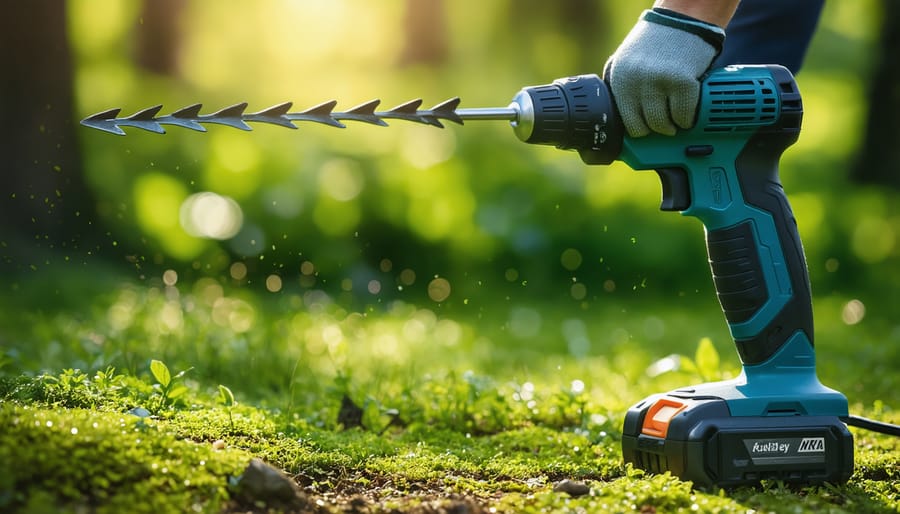
Getting Started: Choosing Your First Garden Electronic
Starting your journey with gardening innovations doesn’t mean you need to invest in every gadget at once. The key is identifying your biggest challenge first. Are you constantly forgetting to water? Struggling with unpredictable weather? Unsure about soil conditions? Your pain point will guide your first purchase.
For container gardens and balconies, start with a simple soil moisture sensor. These affordable devices (often under $30) take the guesswork out of watering and prevent the most common beginner mistake: overwatering. If you’re managing a larger in-ground garden, a smart irrigation controller offers better value by automating your entire watering system.
Consider your tech comfort level honestly. Some devices sync seamlessly with smartphones and offer detailed analytics, while others feature straightforward displays and manual controls. There’s no shame in choosing simplicity—what matters is that you’ll actually use it.
Budget-wise, think long-term savings. A $100 smart irrigation system might seem expensive initially, but it can reduce water bills by 30-50% while improving plant health. Start with one quality device rather than several mediocre ones.
Here’s a simple framework: Identify your primary frustration, set a realistic budget (beginners often succeed starting with $50-150), assess your tech comfort, and read reviews from gardeners with similar setups. Many experienced gardeners I’ve spoken with wish they’d started with just one reliable electronic tool earlier, rather than feeling overwhelmed by trying everything simultaneously.
Remember, these tools should enhance your gardening joy, not complicate it. Choose something that solves a real problem you’re facing today.
Interview Snippet: How a Busy Gardener Uses Tech to Stay on Top
Meet Sarah Chen, a landscape designer and mother of two who transformed her gardening approach with a few strategic electronic additions. “I used to spend my mornings rushing between client sites and home, constantly worried about whether my vegetable garden was getting enough water,” she shares. “My tomatoes would wilt by afternoon, and I’d lost countless seedlings to inconsistent watering.”
Her turning point came when she installed a **Rachio 3 Smart Sprinkler Controller** and paired it with soil moisture sensors. “The difference was immediate,” Sarah explains. “The system waters based on actual soil conditions and weather forecasts, not just a timer. I check my phone during lunch, and if there’s been unexpected rain, the system has already adjusted.”
She also added a **Ring Spotlight Camera** near her raised beds after losing herbs to wildlife. “Now I get alerts when something’s moving around my garden at night. It’s been entertaining watching the neighborhood rabbits, and I’ve protected my investment without harsh deterrents.”
The results? Sarah estimates she’s saving 30% on her water bill and hasn’t lost a single plant to under-watering in over a year. “I’m actually enjoying gardening more now because I’m not stressed about the basics,” she says. “The technology handles the routine monitoring, so I can focus on the creative and rewarding parts—like harvesting fresh basil for dinner.”
The beauty of integrating electronics into your garden is that you don’t need to transform your entire outdoor space overnight. Start small and choose one or two devices that address your biggest gardening headaches. If you’re constantly worried about watering while you’re away, try a simple soil moisture sensor. Struggling with unpredictable frost? A weather station might be your perfect companion.
Remember, these tools are here to support your gardening journey, not replace the therapeutic satisfaction of digging in the soil, pruning your roses, or harvesting tomatoes with your own hands. Technology simply gives you more time to enjoy those moments by handling the repetitive tasks and offering helpful insights when you need them.
As you explore these innovations, you’ll discover what works best for your unique garden and lifestyle. Some gadgets will become indispensable, while others might not fit your needs—and that’s perfectly okay. Experimentation is part of the fun.
We’d love to hear about your experiences with gardening electronics! What devices have made your life easier? What challenges are you hoping to solve? Share your stories with our community and let’s continue learning from each other.

